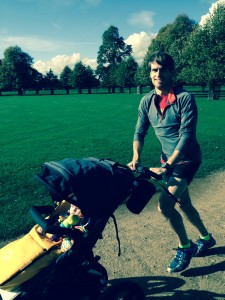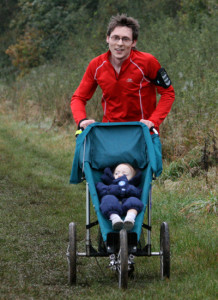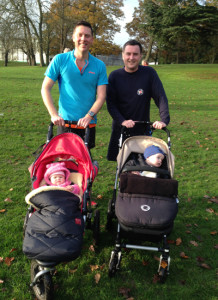I am seconds away from finishing my first London Marathon. I am 18. I am suffering, limping to the finish line. Suddenly, a grey streak passes my right shoulder. I am being overtaken by a Womble. I have no energy to respond. I watch the Womble charge into the distance, arms madly aloft…
Galvanised, I become a better runner, far beyond the reach of Wombles. And so I am embroiled in the final stages of a five-mile pre-Christmas race in Blackpool. It is a fancy dress affair. My costume stretches to a red hat. Up the road is a Christmas pudding, albeit a Christmas pudding running five miles in 29 minutes. I will not catch him. I had better pull out, I reason. Or feign injury. I carry on. “You do know,” my watching mother-in-law informs me soon after, “that you were beaten by a Christmas pudding?” Indeed, she reminds me of this every Christmas.
And this is my running career: a bridesmaid to a Womble and a Christmas pudding.
This all may seem tangential, but what I am saying is: I know how you feel. I can empathise. I understand the ignominy of being outrun by the metaphorical Womble. But I am now doing it to you. Getting my own back. Lots of us are.
Meet the buggy runners.
Pushing the limits
We are multiplying, cascading down parkruns and races. And we are chasing you down. And we mean business. The records are eye-watering. The fastest 10K with a buggy was set by New Zealander, Dougal Thorburn, who clocked 32mins, 26secs. The swiftest buggy marathon time is arguably even more impressive. Racing at the Route 66 marathon in the United States in 2009, Zac Freudenberg ran a startling 2hrs, 32mins and 10secs, while pushing his 10-month-old son.
My daughter was four months old when we embarked on our first run. I laboured around Tooting Bec Common, knocking off eight-minute miles, while I – a typically paranoid new parent – regularly checked she was still breathing. We ventured out again and again, each time going a little faster, going a little further. The runs were unspectacular, dull affairs, though. I longed to be running at a proper pace.
Turning point
Then everything changed. My wife was racing in Surrey one January morning. I was in a car park on Box Hill with a baby and a buggy and several hours to kill. Silenced by one of those ‘biscuits’ that babies devour but taste worse than cardboard, we set off down Box Hill’s zigzags of Olympics fame. We ran on the road. The notion seemed reckless at first, but if cyclists can ride two or three abreast, why can’t I irritate motorists too? That is something I would positively relish.
We flew down that hill. In those couple of miles, I stopped caring what people thought about me and began to see the possibilities of running with a buggy. We turned and began the ascent. There is only so fast you can run with a buggy. The reasons are obvious: wind resistance, weight, altered running style, and so forth. The biggest barrier to speed, however, is the fact that there is a limit to how daring you can be when careering a 10-month-old along a road without social services being alerted.
There is a variable greater than anything I have already noted, however. A great fear. A great inevitability. She will wake. And when she wakes, she will want out of that buggy. I had been going close to 30 minutes when I began the ascent; I was already pushing my luck. I did not hang about. We did not catch a cyclist, frustratingly. But we were close. One overtook us on the first zigzag, then slowed. We were gaining metre by metre, only for the rider to glance over his shoulder and – in recognising the potential shame of being passed by a baby being pushed up Box Hill in a buggy – got off his saddle and tried a bit harder. We went from to top to bottom in 15 minutes: a good effort even without a buggy. The baby had not even opened her eyes.
She was still sleeping as I joined the queue in the summit cafe. As I paid, I tried to wake the baby. She would not stir. She was cold. My mind raced to an implausible catastrophe. I have killed her – somehow – by running up Box Hill. What will my wife say? What will the Daily Mail say?
“Here is your change.”
“Thanks.”
I prodded her cheek again. An eye lazily opened.
“You’ve just run up Box Hill,” I enthused when we were sitting down. Or when I was sitting down. She’d been sitting down the whole time.
She seemed to shrug. Her eyes demanded yoghurt.
Park life
At our first parkrun – three flat loops around Dulwich Park – we easily ducked under 20 minutes. The following weekend, I tried, clocking 18 minutes, 24 seconds. An enforced slow start had meant we were in about 30th place. One by one, we picked them off. Each time, my daughter would glance at the runner, casting a haughty, evil grin, before turning away nonchalantly. Midway in, we were cruising at sub-six minute mile pace, breaking into the top 10.
I had been racing all year, without really enjoying racing. Being the underdog, the guy with the buggy – and being slower as a consequence – was unexpectedly transformative.
Like running in the rain, it is the oddity of buggy running that is its appeal. “I find that non-runners just don’t get it at all,” Steven Stockwell said. “Quite often, I run past people as they stare in disbelief. I’m not sure if that is a sign of disapproval or just shock that someone is putting themselves through the act of running and pushing a buggy at the same time.”
Robert Jones concurs: “The best bit? The breathlessness of other competitors at the end of the race. The look on their faces when they turn round to their dearly beloved as they have run their socks off, maxing their heart rate, top to toe in compression gear, checking and rechecking their Garmin splits. ‘Darling,’ they say, ‘get a photo of me so I can post my time on Facebook and Twitter.’ ‘But, dear husband, you were beaten by a buggy!’”
Beyond the rough and tumble of racing, however, is the simple opportunity for a connection between father and child, a relationship sometimes deliberately, sometimes accidentally, diminished by society.
“We play a lot of games during our runs,” Stockwell said. “Our favourites are the one where I run towards a lamp post and as we get closer, my daughter shouts, ‘Daddy! Lamp post!’ I have to swerve at the last moment in order to avoid crashing into it. While out there on the road, we run in our own exclusive little world that no-one else can ever be part of. Our games and the conversations we have can only really exist in that environment.”
And me? An unlikely metamorphous into a figurative Womble is complete.
Profiles
 Buggy runner: Steven Stockwell
Buggy runner: Steven Stockwell
Wheels: Baby Jogger 2
Role of honour: 5km in 19.49. Furthest non-stop training run of 22.4km in two hours.
Do we need to call social services? We are always especially careful around road crossings and I am always very mindful of other runners’ heels during organised events.
The world of a buggy runner: Non-runners just don’t get it at all. Quite often I run past people as they stare in utter disbelief.
Wheels: Out n About Nipper 360
Role of honour: Sub-21 minute (just) parkrun.
Do we need to call social services? For new year we escaped to Wales and I took the buggy out with my daughter wrapped up really warm in -4C conditions. It was very icy – I was skating behind the buggy in my racing flats with no grip for most of it.
The world of a buggy runner: There is always a warm glow and extra shot of adrenaline through the arteries when overtaking non-buggy runners, looking at the horror in their faces!








